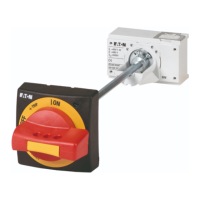4
Installation and Removal Instructions
for Series NRX Spring Release, Latch
Check Switch and Motor Operator
EATON CORPORATION www.eaton.com
Instruction Leaet IL01301010E
effective January 2013
Step 5: While pulling back on the manual charging handle, tilt the
spring release backward so it fits into and under the slot feature on the
breaker sideplate as shown.
Figure 7. Step 5
Step 6: Complete the mounting process by pushing the spring release
forward and securing it in place with its captive retaining screw. Use a
screwdriver to hand tighten the retaining screw.
Step 7: Make the appropriate secondary connections as outlined
in Section 9. If necessary, bundle secondary wires using industry-
accepted wire tie practices.
Step 8: Replace the front cover and secure it in place with the four
mounting screws previously removed in Step 1.
Section 3: Removal of spring release
Proceed with the following four steps:
Step 1: Remove the front cover from the breaker by first performing
Steps 1 and 2 of Section 2.
Step 2: Locate the spring release and disconnect the appropriate
secondary connection as described in Section 9.
Figure 8.
Spring Release
Step 2
Step 3: Unscrew the captive retaining screw from the spring release
and remove the spring release. Pulling forward on the manual charging
handle simplifies removal.
Step 4: If another spring release is to be installed, perform Steps
3 through 8 of Section 2. If not, complete the removal operation by
performing Step 8 of Section 2.
Section 4: Installation of latch check
switch in spring release
Proceed with the following five steps:
Step 1: Remove the spring release from the breaker prior to installing
a latch check switch by performing Steps 1 through 3 of Section 3.
Step 2: Position the spring release as shown. Tilt the latch check switch
back to properly position it for final installation. The LCS is shown
without leads soldered to appropriate terminals for clarity purposes
(Figure 9).
Figure 9. Step 2
Step 3: Carefully press the latch check switch down as shown until a
snapping sound is heard. This sound indicates the switch is properly
seated (Figure 10).
Figure 10. Step 3

